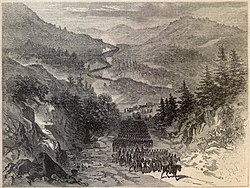Battle of the Cumberland Gap (1863)
| Battle of the Cumberland Gap | |||||||
|---|---|---|---|---|---|---|---|
| Part of the American Civil War | |||||||
 |
|||||||
|
|||||||
| Belligerents | |||||||
|
|
|
||||||
| Commanders and leaders | |||||||
| Ambrose E. Burnside | John W. Frazer | ||||||
| Strength | |||||||
| 3 brigades | 2,400 | ||||||
| Casualties and losses | |||||||
| 0 | 2,300 surrendered | ||||||
The September 7–9, 1863 fall of the Cumberland Gap was a victory for Union forces under the command of Ambrose Burnside during his campaign for Knoxville. The bloodless engagement cost the Confederates 2,300 men and control of the Cumberland Gap.
Major General Ambrose Burnside, commander of the Department and Army of the Ohio, began to advance against Knoxville, Tennessee. Burnside left Cincinnati, Ohio in mid-August 1863. The direct route ran through the Confederate-held Cumberland Gap. Burnside had been delayed in earlier attempts to move out against Knoxville and thus chose not to spend the time to force a passage of the gap. Instead he detached one brigade under Colonel John F. DeCourcy to pose a threat to Brigadier General John W. Frazer's 2,300 man garrison, while the rest of the army bypassed to the south over 40 miles in rugged mountainous terrain. DeCourcy had previously led a brigade in the 1862 operations against the Cumberland Gap under George W. Morgan.
Despite this, Burnside made a rapid advance on Knoxville. Many of the Confederates in eastern Tennessee had been withdrawn for the upcoming Battle of Chickamauga, leaving only two brigades under General Sam Jones (including Frazer's). Having successfully occupied Knoxville on September 2, Burnside could now return his attention to the Cumberland Gap.
Frazer and his 2,300-man garrison had little combat experience, yet they had the benefit of a strong natural defense. Frazer's men supplemented this by digging their own trenches. General Simon B. Buckner had given Frazer orders to hold the gap at all cost, yet when Buckner and all his troops were redeployed, no contingency had been formulated for retreat and therefore Frazer continued following his orders from Buckner to hold the gap. DeCourcy's brigade threatened the Confederates from the north, but his brigade alone was not enough to force Frazer out of the gap. Burnside dispatched a second brigade under Brigadier General James M. Shackelford. Shackelford approached from the south and, on September 7, asked for Frazer's surrender. There were still not enough Union troops to convince Frazer to surrender. An ineffectual exchange of artillery followed but that evening Union soldier captured Gap Springs, the Confederate water supply. On September 8 Burnside personally left Knoxville with a brigade under Colonel Samuel A. Gilbert and marched 60 miles in just over a day. Meanwhile, both DeCourcy and Shackelford sent messages demanding surrender. Attempting to buy time, Frazer met with the two Union commanders separately, but rejected surrender demands from both.
...
Wikipedia
